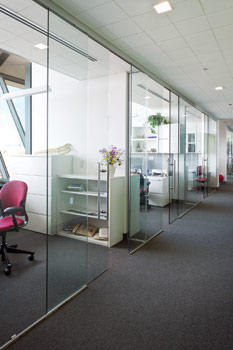Interior Sliding Frameless Glass Doors Make a Clear Contribution to LEED
Frame Components
If a large expanse of glass is the desired aesthetic, frames can be minimal. In fact, in the latest sliding glass door and moveable partition options, frame components consist of only 4 percent of the overall material used in the opening, which can be important to daylighting goals and other LEED criteria. The main upper extrusion that holds the glass panels is mainly made of aluminum with manufacturers offering a large range of finishes from clear anodized to any RAL color finishes to match the look and feel of the interior design scheme. This minimum framing provides aesthetics, durability, light weight, and ease of recyclability.
| Glass Doors Help Achieve LEED Gold at the San Diego National Wildlife Refuge |
||
Light and open was the design rationale for the recently constructed $4.9-million, 8,000-square-foot San Diego National Wildlife Refuge—an approach that helped earn LEED Gold status. The center provides Fish and Wildlife Service staff with offices and collaboration areas in which they can now perform their work within the marsh. “We wanted to give both staff and visitors a strong connection to the landscape by providing plenty of light and openness within the facility,” says SD Wildlife National Refugee Design Rationale Project architect Johnny Birkinbine, AIA, of Line and Space, LLC. One way the design team achieved its goal was the use of interior sliding glass door systems as partition walls between the staff offices and the corridors. The same system was also used on the conference room. “The use of floor-to-ceiling glass walls provided us with the transparency we wanted in order to provide the staff with views of the exterior,” Birkinbine says. “They also allow plenty of natural daylight to penetrate the interior of the building, once again connecting the staff with the exterior.”
Birkinbine is enthusiastic about the use of the doors’ frameless design. “We wanted as much natural light as possible to penetrate into the space,” he says. “This not only provided the feeling of openness we desired, but also minimized the need for conventional lighting, resulting in significant energy savings.” Birkinbine says the glass partition walls also helped the facility attain LEED Gold—New Construction certification. According to the architect, the ability of the glass walls to extend natural daylight deep into the interior of the space helped increase energy efficiency and contributed to the “Daylight and Views” credit. Another design element that appealed to Birkinbine was the lack of a track on the doorway floor. The sliding panel is ceiling mounted, resulting in a clear passageway with no floor profile. “We were looking for the cleanest installation possible,” the architect notes. “The use of glass offered us a clean, crisp, contemporary visual that also provided transparency, views, and plenty of natural light.” He also notes the use of a short, 90-degree glass panel return between the glass office front and the drywall partition that separates offices. “If we had extended the drywall all the way out to the corridor wall, we would have broken the rhythm of the glass plane and also lost some of the transparency we were looking for,” he says. |










